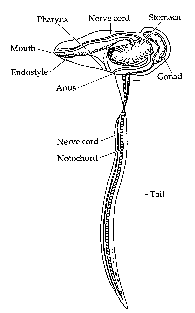Tadpoles of the sea |
Tadpoles of the sea |
|
SHAPED LIKE TADPOLES, but quite unlike them in any other way, are the appendicularians, of the class Larvacea of creatures known as urochordates. Zoologists have a hard time trying to figure out exactly where these creatures fit in the supposed alleged evolutionary scheme. Since these animals appear very similar to the larvae of sea squirts they have proposed that these creatures are in fact sea squirts that somehow learned to reproduce sexually before turning into adults. They apparently were so happy with this arrangement that they have remained in that condition since time immemorial. In more technical terms, these animals “have become specialized by the retention of an essentially larval organization after the onset of maturity and the development of gonads” (Russell-Hunter, A Life of Invertebrates, p. 562). These quaint critters ply the upper waters of the oceans of the world, earning their keep by trapping fellow plankton members in a remarkable net of hardened mucus that they secrete. Appendicularians build and live inside a small balloon of mucus that is equipped with miniature filters. By gentle beating of their tadpole-like tail, plankton-laden water is wafted through these intricate filters, leaving behind plankton cells that become ensnared. The fine mesh of the filter is able to trap even bacteria in large numbers. The path of the water through the house does not just go straight through it, but follows a rather complex path, determined by the intricacies of the net, before exiting. The rear end of the house has a flap valve that requires a buildup of internal pressure to open and let the water out, at the same time propelling the animal forward. Once the particles are trapped in the feeding filters, the appendicularian ingests them in a truly remarkable way. Once every few seconds the animal sucks the particles off the feeding filter and up into its mouth — just like sucking through a straw. Inside the mouth is a porous mucus funnel that extends into the stomach. The particles get stuck on the mucus, which is constantly being wound into a thin string which is reeled in and digested. The animal proper is quite small, rarely more than a centimeter long. Its mucus house, however, may be as large as a walnut. In some species the balloon surrounds the entire body of the animal. In others, the house is limited to a small gelatinous bubble protruding from the mouth like bubble gum. This plankton-capturing mucus house, with its intricate filters and miniature nets, is one of the most complex external structures built by any organism. The concept of trapping things in a net may seem simple to us. After all, we don't find fish netting complex or mysterious. However, when it comes to appendicularian nets, it is a horse of a different color. Scientists are simply not sure how it works. Appendicularians discard and build a new house about every four hours. The first problem the animal faces is freeing itself from its rundown shack. A spring-loaded trap door at the front end makes for an escape hatch. How the new house is constructed is both amazing and intriguing, testifying to the ingenuity of our God. The mucus that forms the walls and filters of the house consists of a gelatinous material that is secreted on the surface of the animal's body, excluding the "tail", by a layer of specialized glandular cells. The pattern of these glandular cells within the skin varies with the species. This pattern determines the structure and shape of the house. To make matters more complicated, different groups of cells on the animal's surface manufacture mucus of different density and elasticity. Thus, on expansion, the mucus takes a variety of shapes that contribute to the complexity of the end product. One region with specialized cells, for example, is responsible for making a mesh that covers the opening to the house. Another group produces the feeding filter. After the mucus is formed in these special cells, it is transferred to the very outside of the body, where it awaits expansion. Remember, the final shape of the balloon is already determined before expansion.  When the old house-filter becomes clogged with gunk, the creature discards it. It is time to expand the new one. First, it swims intermittently with a jerking motion for several minutes. During this period, the "embryo" of the new house expands slightly into a capsule that fits like a glove around the front end of the body. The animal then begins a series of violent movements to wriggle partially out of the growing house. Sometimes it cartwheels, or nods back and forth. These movements free the animal from its tight glove, and make the glove begin to grow bigger. When it is big enough, our friend pulls his tail into the house, and commences to beat it gently. This pumps water inside, with the effect of expanding it still further, until eventually it reaches full size. And there you have it. Isn't it amazing what millions of years of evolution can do! At times, the discarded houses of many appendicularians become so concentrated in a given area that they resemble quantities of drifting snowflakes. Such concentrations are often referred to as "marine snow." As with most everything in God's creation, these abandoned homes don't go to waste. Many other kinds of minute animals live on the surfaces of cast off houses, peacefully grazing on the mucus and the particles trapped in it. Bacteria and protozoans are amongst their number. Of course, much, much more could be said about these miniature marvels that sing the praises of the Great Designer. But hopefully this is enough to give us a keyhole glimpse into another example of the myriad wonders of God's handiwork.
Diagram from "Embryology: Constructing the Organism", by Gilbert and Raunio, taken from Holland and others 1994) |